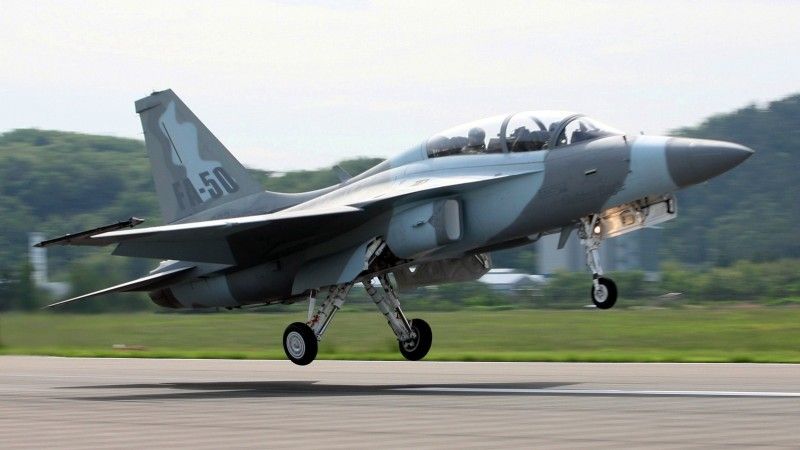Eyes and Ears of the Polish Fighters from Korea. What Radar for Polish FA-50s?

The FA-50PL light fighter platform, procured by the Polish Armed Forces, would be fitted with an AESA sensor, as the second of the recently signed performance contracts envisages. This is the key piece of hardware, allowing for the neutralization of air threats at medium ranges. So far, a couple of systems have remained on the table, coming from Korea, the United States, or even Israel.
The contracts signed by the Armament Agency, and approved by Mariusz Błaszczak, head of the Polish MoD, concern two FA-50 light combat aircraft variants. The first one is seen as a gap-filler solution - 12 jets available in the existing variant, procured to replace the MiG-29 Fulcrums stationed at the Minsk Mazowiecki AB. These would be fitted with a light, Israeli EL/M-2032 radar, and armed with Sidewinder air-to-air (but not the AIM-9X), and AGM-65 Maverick air-to-ground missiles, along with several types of bombs. EL-M/2032 radar features a mechanically scanned array. It has been used, for a long time, in modernized legacy air platforms for quite some time now, such as MiG-21 LanceR (Romania), IAI Kfir, F-4E Terminator 2020 (Turkey), and F-5E Tiger Plus (Chile).
The second variant - FA-50PL - would be delivered between 2025 and 2028. It is to be far more advanced. The jet is to be retrofitted with new equipment, and it is to be able to carry more weapons and offer a greater operational radius - also thanks to the air refueling capability. The FA-50PL is to offer capabilities that are referred to as "close to those of an F-16". The AESA radar would be the key component that would provide the jet with those new capabilities. The aforesaid sensor is to work with the AIM-120 AMRAAM, allowing the FA-50 to act against targets at medium ranges. The radar would also be an added value in the air-to-ground department. It is yet to be decided, as to what AESA radar would be used.
Lt. Col. Krzysztof Płatek, speaking to Defence24.pl, said that the Korean LIG NEX1 radar was designated as the preferred, preliminary choice for the FA-50PL. This does not mean the decision is final - we need to wait until next year for that step to be made. The FA-50PL is to utilize the radar-guided AIM-120 AMRAAM missiles that would work with the jet's radar. Integration would be required, and that integration would also depend on the radar that is to be ultimately chosen. It is possible to select another AESA sensor that would meet the baseline requirements, also allowing for a hassle-free AMRAAM integration. It is not a secret that other radars exist, that could be used on FA-50PL, and these have already been integrated with the AMRAAM, or the AMRAAM would work with the radar immediately.

As of now, the performance contract includes provisions on the preparatory steps required for the AIM-120 integration. The final decision on the scope of work required for that to happen has been postponed, at least until 2023, when the radar selection is expected to take place. This is the main reason why the FA-50PL communications often mention the AIM-120 AMRAAM integration as "the next step". One should add that the missile has also been repeatedly integrated with radars supplied by manufacturers from outside of the US (Radar/Aircraft such as SaabPS-05/A/Gripen, Selex Raven ES-05/Gripen NG, or CAPTOR/Eurofighter).
FA-50PL - What radar?
There are, thus, at least several options, when it comes to the radar for the Polish light fighter platform. The first one comes in a form of a Korean sensor. The radar is currently in the final stages of its development. It has been tailor-made for FA-50 Block 20 - which should make the potential integration far easier. One should remember, that the integration of the AMRAAM missile should be handled separately in this scenario.
US-made radars are among the possible alternatives. No official confirmations have been made, when it comes to specific radar types. Based on the available data one could conclude that the US defence industry offers at least several sensors that could meet and fit the Polish FA-50 requirement. Any of those radars in an AESA sensor that also is, or will be integrated with the AMRAAMs. However, any acquisition of those would also entail the integration of a radar different than LIG NEX1, designed for the fighter in question.
One of the possible US options is heavier than the sensor designed for FA-50. However, the jet has enough space and energy available to integrate a heavier sensor as such.
We are speaking of the AN/APG-83 SABR radar. This Northrop Grumman’s radar uses much of the know-how and experience gathered when the 5th generation F-35 sensors were being developed. The aforesaid radar is a part of the USAF F-16 upgrade, regarding the F-16s that would be tasked with CONUS air defence, and operations in Europe. The package in question has also been procured by foreign buyers - Greece, Taiwan, or South Korea. The very same radar is also offered with brand-new F-16s.
These radars are rated highly by USAF, as they are seen as significantly advantageous, over the current sensors of the F-16, when it comes to tracking and detecting low-RCS targets, such as cruise missiles. If the SABR sensor integration is possible on FA-50, then the BVR target detection and tracking capacity of the light fighter would be on par with the one of the upgraded F-16s.

Photo. USAF
Raytheon Technologies also offers some AESA sensors. A decade ago, Raytheon unveiled its AN/APG-84 RACR radar, offered to the Republic of Korea. Seoul was to originally upgrade its F-16s based on the BAE Systems' offer. However, finally, Korea decided to go with Lockheed Martin's package, including Northrop Grumman's SABR radar. Meanwhile, production of AN/APG-79(v)4 Raytheon's radar designed based on the Super Hornets' sensor (different AN/APG-79 variant), and using the GaN technology, has recently been launched - to modernize the USMC F/A-18C/D Hornet fleet.
Raytheon has also started promoting the PhantomStrike radar recently, also with the FA-50 in mind. That sensor, thanks to the GaN technology, and its cooling systems, is to be lightweight, and energy efficient. Two variants of this radar would be available for export as of 2025, as IHS Jane’s suggested. As Raytheon is also the manufacturer of the AMRAAM missile, it can be assumed, with almost 100% certainty, that AMRAAM integration would be the case for all of Raytheon's sensors.

Photo. IAI
Alternatively, an Israeli radar could also be considered. The above does not refer to EL/M-2032, but its successor: the EL/M-2052 AESA sensor, with performance much higher than one associated with the predecessor. This radar is to be used on one of the variants of the light LCA Tejas Indian fighter. It can work with the Israeli I-Derby ER missiles that offer a range of more than 100 kilometers, which is a testimony of this sensor's broad BVR weapons capability. Technically then, AMRAAM integration is probably feasible, however, as in the case of the Korean sensor, this would require consent from the US. The said radar is being offered as an upgrade of jets using the EL/M-2032 sensors - Kfirs and FA-50 for instance.
As we can see, numerous solutions are offered, when it comes to the FA-50 radar. All options have a set of specific traits, when it comes to manufacturing readiness, R&D status or necessity, FA-50 integration, energy requirements, or AMRAAM integration. All those factors may have a decisive role in the selection of radar. They may also have an impact on the work progress, taking place from now, until the actual selection of the desired sensor.
The decision the Polish Air Force is to make, when it comes to the selection of the radar, would have a fundamental impact on the FA-50 capabilities. If the relevant AMRAAM-integrated AESA sensor is integrated early enough, the light Korean fighter would become a serious adversary that could fight against a much heavier platform. They would also come with a great air defence potential, being able to down cruise missiles for instance. Meanwhile, until BVR/medium distance capabilities gap is filled, the FA-50 does not offer much, when it comes to air combat.



